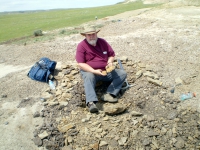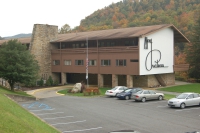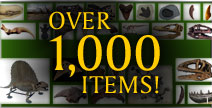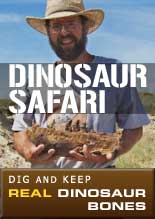
Hidden Treasures at the West Virginia Geological & Economic Survey Museum
Woolly mammoths, cave lions, giant cheetahs, vampire bats and giant armadillos once ruled the mountains. Dragonflies with three-foot wingspans thundered through the air beneath towering tree-sized plants, which would someday become vast coal deposits. Beastly reptiles used their large fins to warm their bodies in the midday sun and muster energy to kill. Sound like make-believe stories? Nope. Just part of the rich natural history of the Appalachian Mountains. Journey to the past at the West Virginia Geological & Economic Survey Museum. And don't worry--the dinosaurs are extinct.
Nestled at the downstream end of Cheat River Canyon sits a remarkable museum of rocks, minerals, fossils and other oddities in the form of the West Virginia Geological & Economic Survey Natural History Museum. (WVGES) WVGES and the museum are at the end of a dead end road just past the Edgewater Marina and as such is a bit off the beaten path. However they have been there since 197? and are housed in the old Mont Chateau State Park which closed in 197?. As you can imagine as a former state park it is in a rustic looking building in a beautiful setting. WVGES was founded by an act of the Legislature in 1897 with the purpose to investigate the State's geological and physical resources, make the results of these investigations promptly available to the public, and provide topographic, geologic, and other maps of the State. Over the past 117 years WVGES has done just that with hundreds of publications, reports and maps.
Being a geological survey there have always been rocks, mineral and fossils around the building and offices. After all most of the staff is comprised of geologists. When WVGES moved from White Hall on the WVU downtown campus to Mont Chateau in 197? the large lobby became a logical location for displaying of geologic specimens and over the years a few glass display cases have been added. In the 1990’s the museum was beginning to take on a more formal look and E Ray Garton was appointed as the museum curator in 1993. More display cases were added, and more specimens were sought and displayed.
Showcasing the rich and varied story of West Virginia's geology became a mission of the museum. The Museum was further established for the collection, preparation, preservation, and exhibition of rock, mineral, and fossil specimens from all ages of West Virginia's geologic history. In addition to being a repository for all types of geologic specimens, the museum's ongoing collections also include historic books, maps, manuscripts, and artifacts.
The museum's goal is to provide West Virginians and other visitors an opportunity to examine geologic specimens and explore the geologic processes responsible for West Virginia's outstanding scenery and great mineral wealth. The museum aims to give visitors an understanding of how geology makes the Mountain State unique, and hopefully inspire visits to West Virginia's scenic treasures time and time again.
A main attraction of the museum is replicas of Thomas Jefferson’s old bones. In 1796 the bones of a large animal found in a Monroe County, WV cave during saltpeter mining operations were sent to Jefferson who thought they were the bones of a giant lion based on the huge claw bones sent to him. Jefferson named the animal Megalonyx, meaning giant claw. He later realized that after seeing a publication on giant ground sloths that the bones were actually from a giant sloth. Casper Wistar, a prominent scientist of the day, then named the animal Megalonyx jeffersoni in honor of Jefferson. In 2008 museum curator Ray Garton wrote legislation designating Megalonyx jeffersoni as the official State Fossil of West Virginia. The display of replica bones from Jefferson’s sloth include the right front foot bones with claws and the ulna and radius of the arm. The original bones are in the Philadelphia Academy of Science Museum. Carbon 14 dating of additional sloth bones found in the same cave are 38,000 years old. This time period was during one of the warm interglacial periods of the Pleistocene, Ice Age, when the area had a more Florida like climate.
Another feature of the museum includes a 16-foot-long 10-foot-tall dinosaur skeleton found in North Dakota in 2003. Museum curator Ray Garton helped excavate the skeleton and then had it prepared, mounted and displayed. The skeleton is of an Edmontosaurus (hadrosaur duck-bill). It was one of the largest herbivorous dinosaurs of the late Cretaceous age of about 65 million years ago. Edmontosaurus was probably a herding animal and probably a favorite meal of Tyrannosaurus rex.
Fossil Displays
West Virginia has abundant fossils, especially Paleozoic plants and brachiopods. Other less abundant forms include crinoids, gastropods, bivalves and trilobites. The oldest fossils in West Virginia are algal masses called Cryptozoon found in the Cambrian Age, Conococheague Limestone. The Conococheague is found in 2 narrow bands crossing Berkeley and Jefferson Counties. The youngest fossils found in the state are Pleistocene bones and plants as young as 10,000 years.
Other Museum Features
Rock Displays
Most of bedrock exposed at the surface in West Virginia is sedimentary in origin, deposited during the Paleozoic Era (545 to 230 million years ago); very few igneous or metamorphic rocks are exposed at the surface due to deep burial beneath the thick Paleozoic cover. The oldest exposed rock in the State, found in the tip of the eastern panhandle, is the Precambrian Catoctin Greenstone, a metamorphosed lava that erupted 800 million years ago. There are numerous igneous intrusions of Jurassic and Eocene age rocks in east central West Virginia, especially Pendleton County. The youngest rocks are Pleistocene age travertine found in caves and some large surface marl deposits.
Mineral Displays
Although West Virginia is not known for exotic mineral specimens, one notable exception is a 34.46-carat diamond found in 1910 near Peterstown, WV. Our official state gemstone is a form of chalcedony or agate that replaces the marine fossil coral Lithostrotionella. This microcrystalline form of quartz has beautiful shades of red, yellow, blue and black. When cut the stone takes a high polish and can be used in making beautiful jewelry. Although more rare, banded agates are also found. There are a few localities in the state where quartz crystals occur which are sometimes double terminated and clear. Pyrite is abundant in both our limestone and coal beds, and calcite, often occurring in a variety of colors including white, pink and tan is found in our limestone. Both Barite and Fluorite occur, but are not found as often. In addition, micro zeolites occur in our igneous rocks.
Dinosaur Displays
No dinosaur fossils have been found in the State because the sedimentary rocks in West Virginia are too old (Paleozoic in age). Dinosaurs existed during the Mesozoic Era and there are no sedimentary rocks of Mesozoic age in the State. Any Mesozoic rocks that might have covered the State have been eroded away. None the less we do have fossils of large prehistoric amphibians and reptiles that preceded the dinosaurs such as Dimetrodon, Edaphosaurus, and Eryops. You will also find replica skulls of Tyrannosaurus rex, Triceratops and Allosaurus on display at the museum.
Trilobite Displays
Next to dinosaurs’ trilobites are probably the most popular and best-known fossils. They were a dominant marine life form during the Paleozoic from 543-248 million years ago. There are over 40,000 known species. All trilobites became extinct during the Permian mass extinction event that took place about 248 million years ago. While not abundant, dozens of different species are found in the state. The largest trilobite found in the state is a species of Homalonotus found in Hampshire County. It is 9 inches long with perhaps 2 inches of the tail missing.
23 Foot Snake Skin
Geologist Sam Pees came upon one of the largest known Anaconda’s during his geologic fieldwork in Peru in 1958. The snake had swallowed a 6-foot alligator. The 23-foot skin and photo documentation are on display in the museum.
Journey to the past at the West Virginia Geological & Economic Survey Museum. And don't worry--the dinosaurs are extinct. The museum is just off Exit 10 on I-68 near Morgantown, WV. It is free and open to the public with hours Monday-Friday 8-5. There are over 500 cataloged specimens and most of them are on display. There is even a small gift shop where you can purchase fossil and mineral specimens, books and educational kits.
For more information write to West Virginia Geological & Economic Survey Museum, 1 Mont Chateau Road, Morgantown, WV 26508 or call 304-594-2331 or email [email protected] or visit the website http://www.wvgs.wvnet.edu/www/index.html
Free Exhibits & Museums
Monday-Friday 9 to 5
Item 3216
Category: Educational
Class: Not Specified
MORE PHOTOS:




Now Over 1,000 Items!
PrehistoricStore.com offers the largest selection of replica fossils and other fossil-related products anywhere in the world!
Download a Full Catalog (3MB PDF)
OVER 260 PAGES OF REPLICAS AND MORE!
